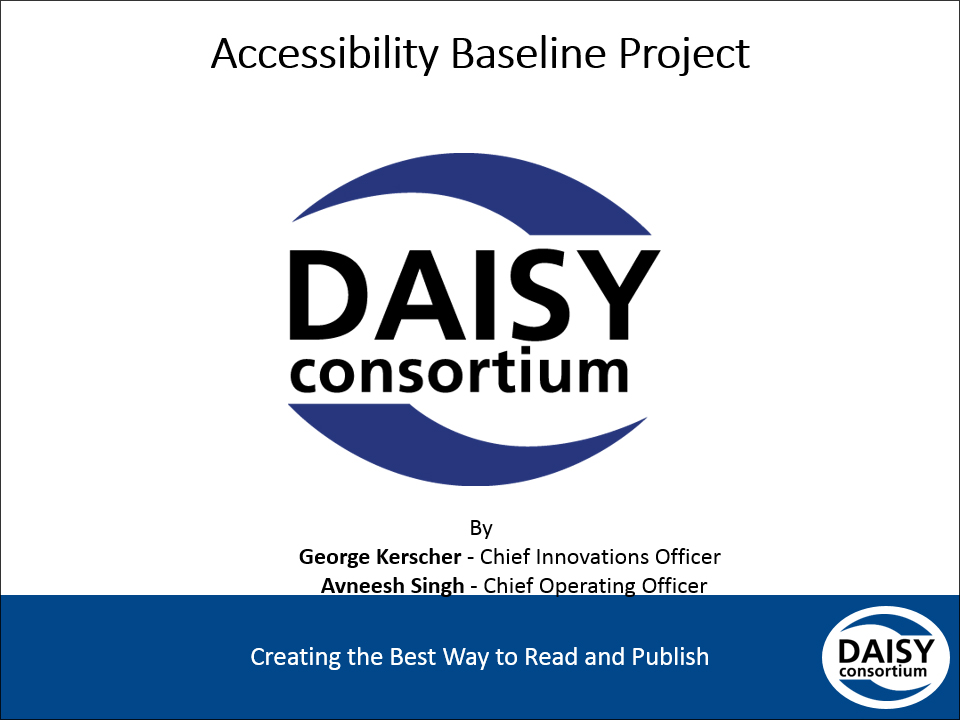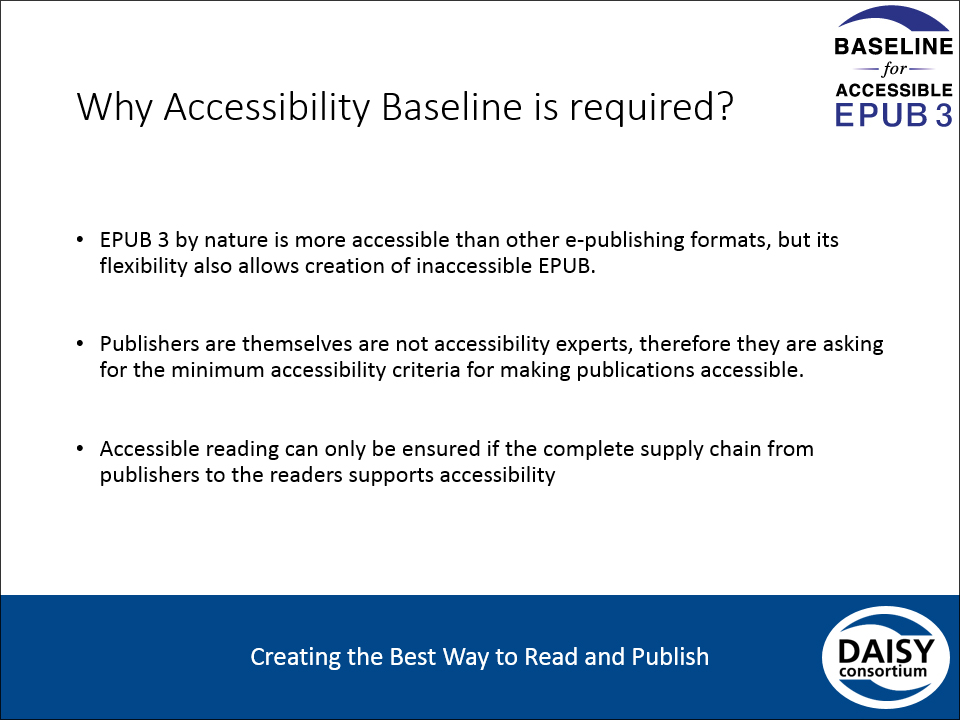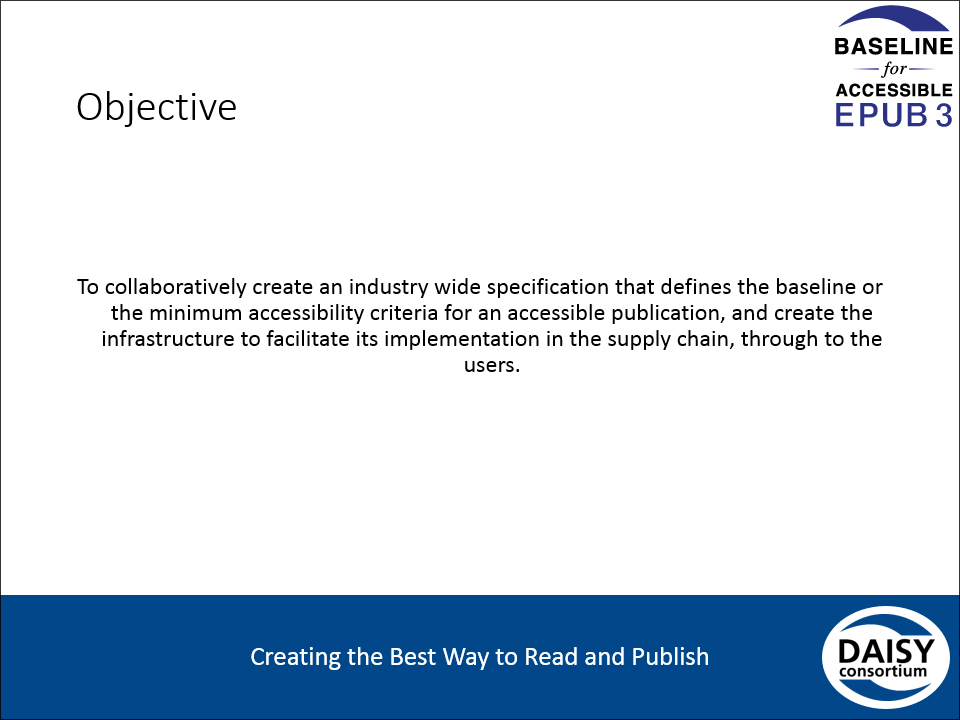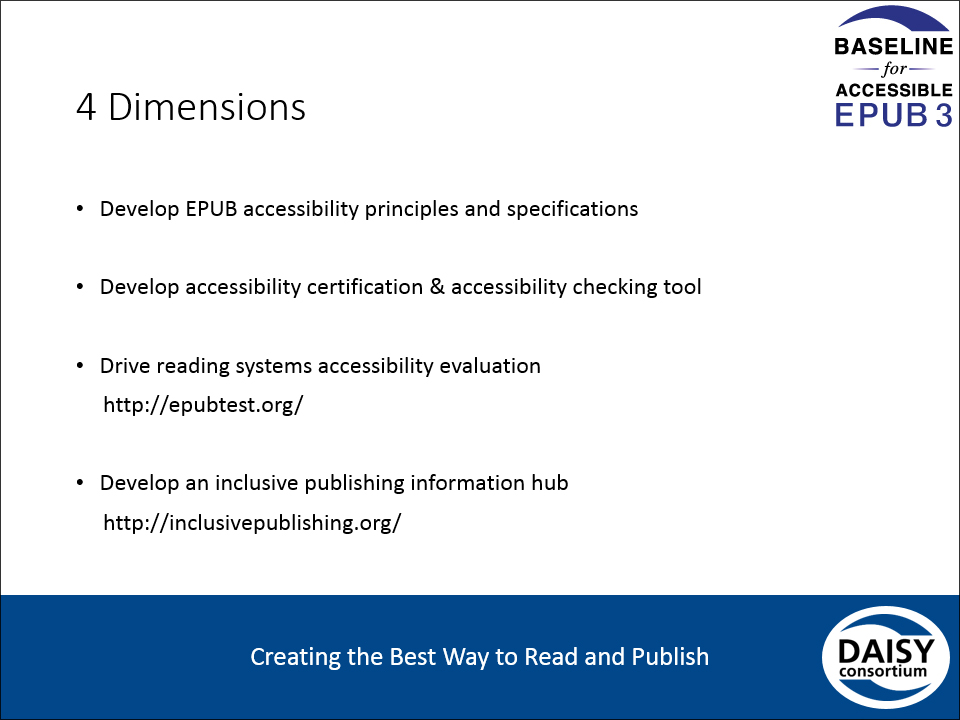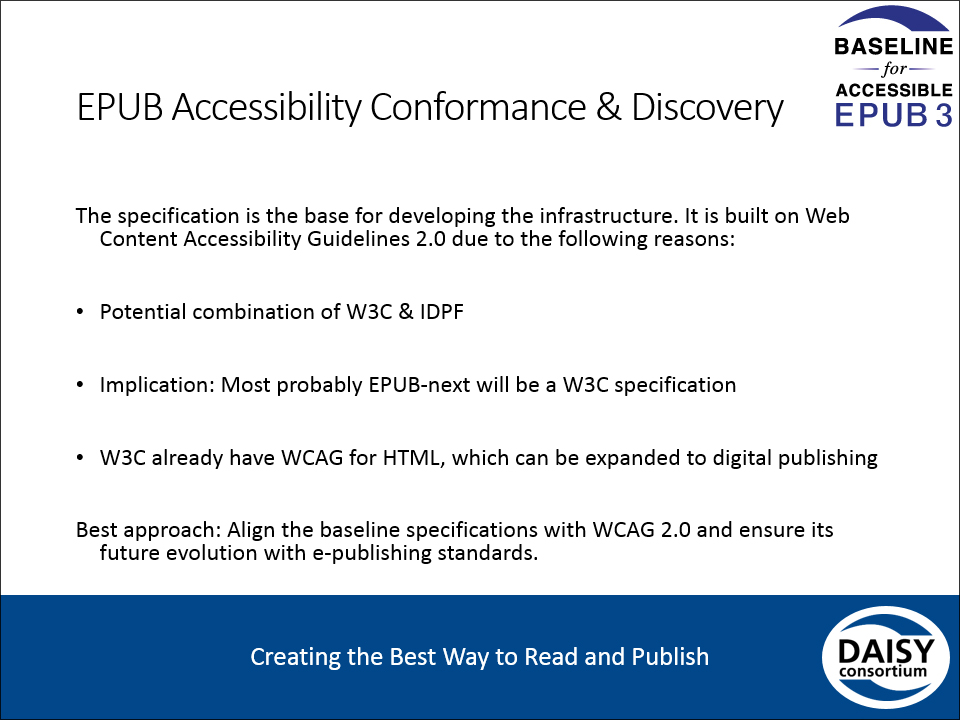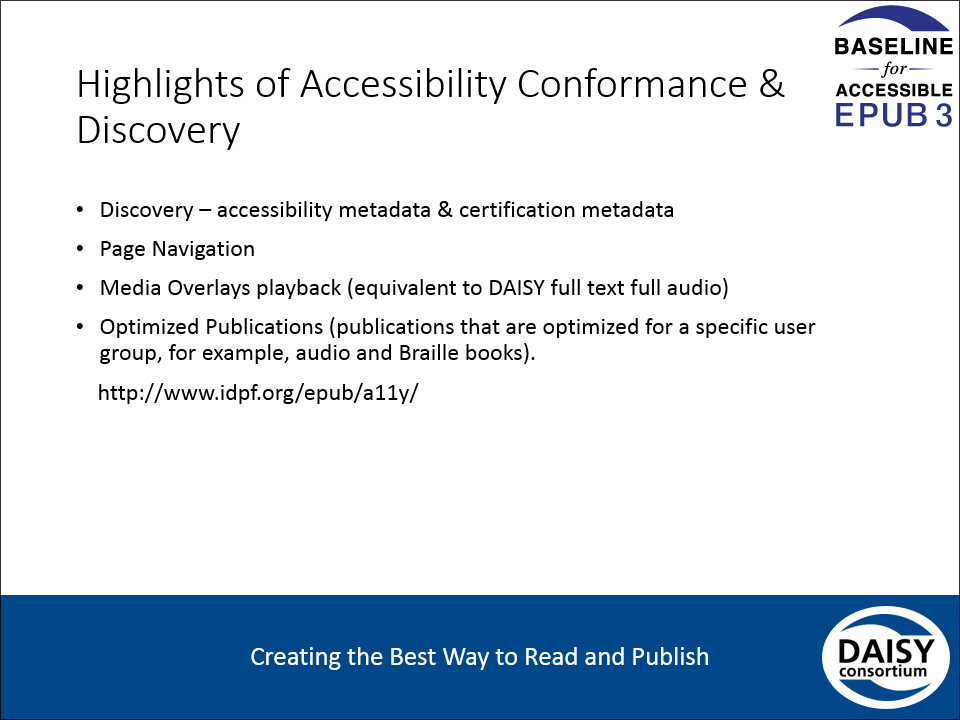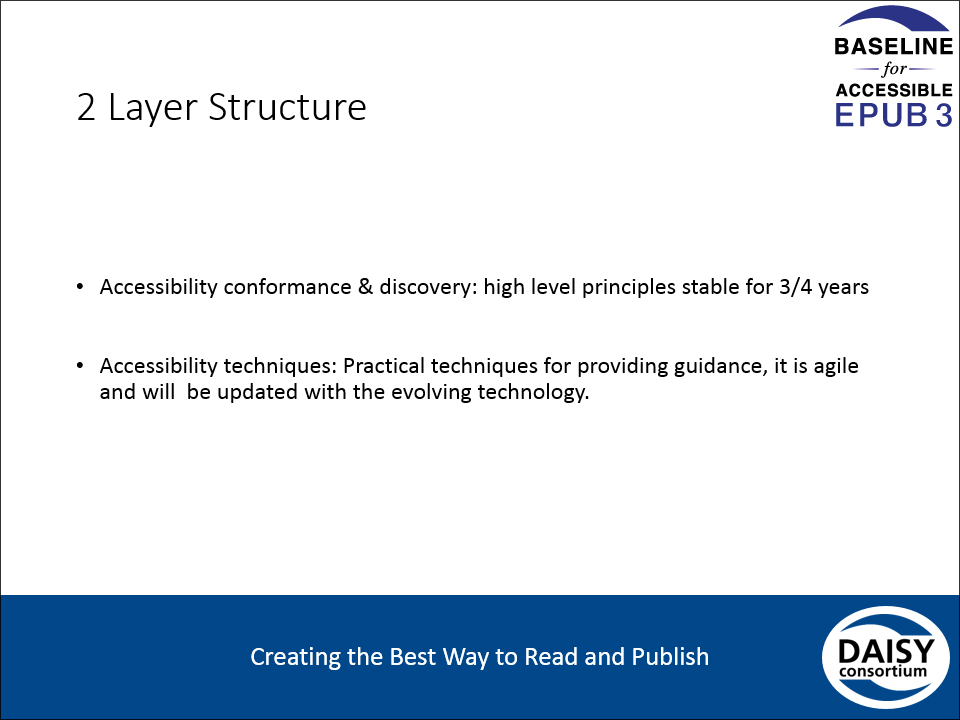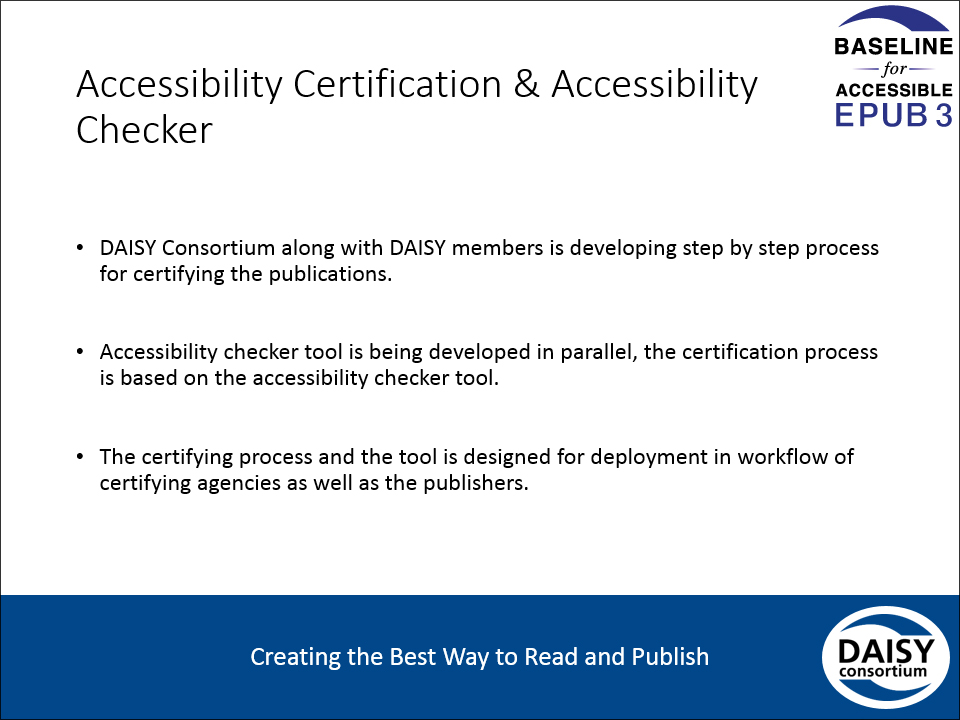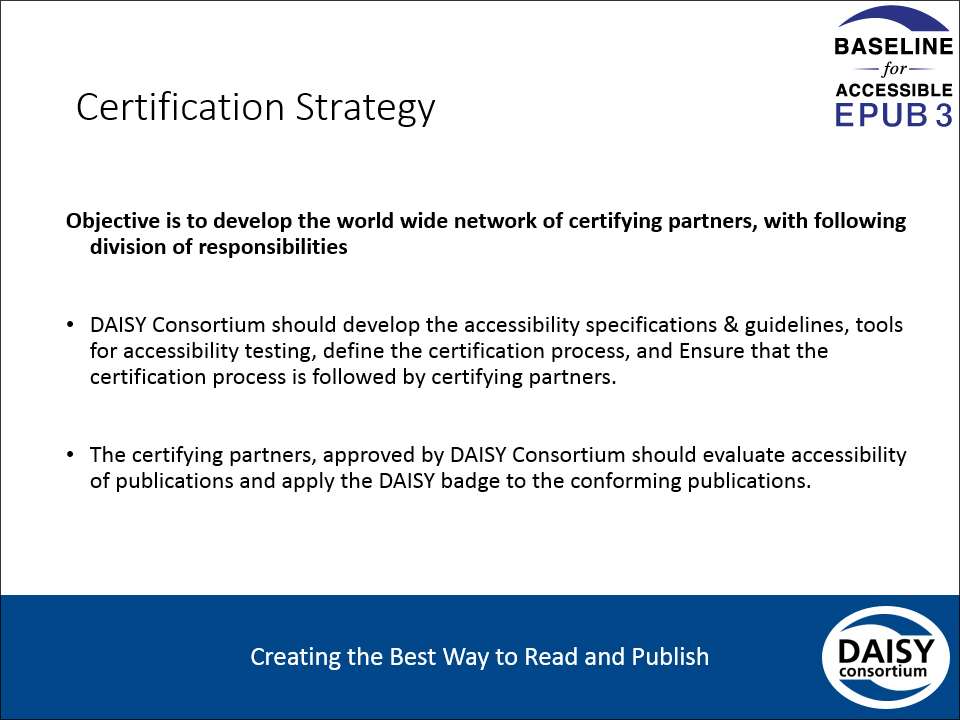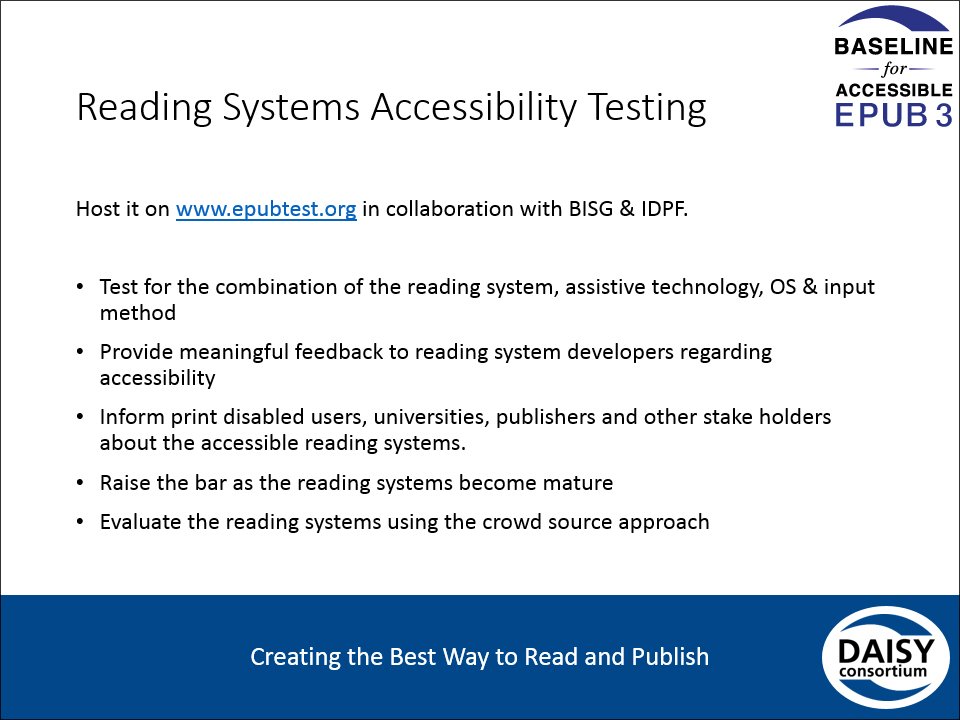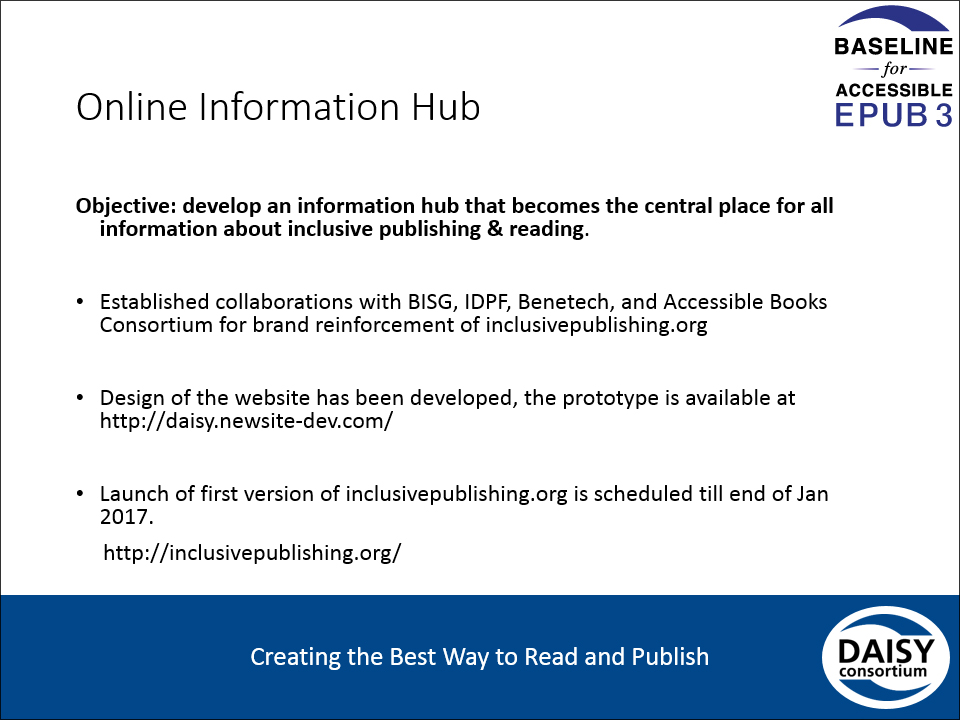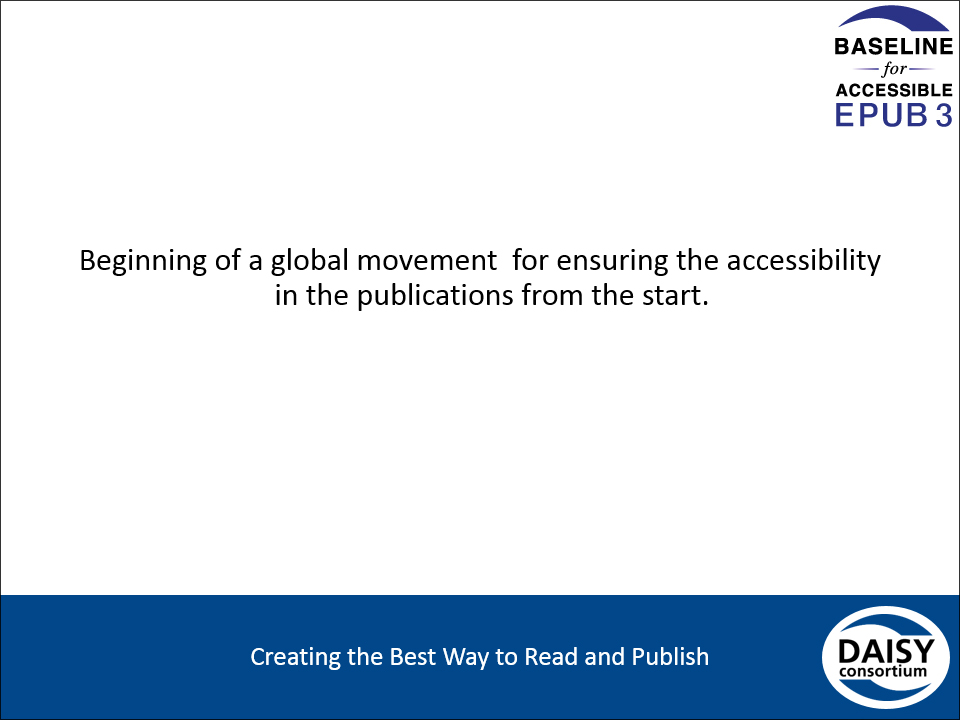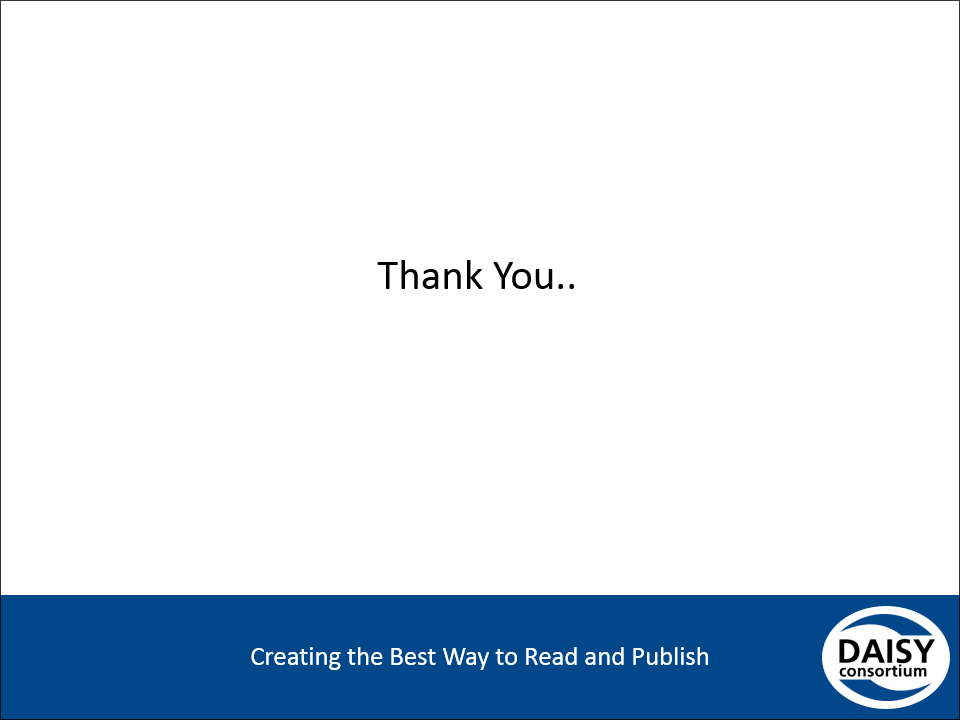Lecture 3: EPUB Accessibility Conformance and Discovery Specification: the baseline for Educational Publishing
George Kerscher
Chief Innovation Officer, DAISY Consortium
President of IDPF
United States

Thank you very much; it's an honor to be here today. Thank you, Nippon Foundation, JSRPD and the Japanese DAISY Consortium. So we've got some slides, we're going to be talking about the baseline initiative, and much of this is started in work on standards. Through standards we believe we can get the baseline that Brad was talking about, implemented around the world. So I'm going to go to slide two…
So we want to develop an infrastructure that goes through the complete supply chain, from creation through distribution into the distribution chain, to the end user, search and discovery, purchasing, all of the aspects of the lifecycle of a digital book needs to be accessible. If any part of that chain is broken, we end up with the person with the disability not being able to access that material. So everything really does need to be examined and nothing can be left out. And we're focusing on making sure that's really clear to everybody.
So we have four dimensions to the work that we are doing. First we need the EPUB specification for accessibility. That has been developed; Avneesh Singh from DAISY and Charles LaPierre have been the co-chairs of the EPUB accessibility discovery and conformance specification. That's been fabulous development with publisher input and the whole industry has been collaborating with the development of that; in conjunction, we're developing the EPUB 3.1. They're finished now, and voting by the membership will begin really soon in the next couple of weeks, and by the end of the year, both of these will be official standards. So that's the first piece: we need to have the standard that identifies and explains the conformance and discovery of the accessible books.
We need an accessibility certification checking tool and a process that can be replicated anywhere in the world. So that software is going to be developed, much of it will build on HTML checking tools, because EPUB is fundamentally HTML inside zipped up, so we can build on HTML for the accessibility. But there are things that are part of books that are not web pages. They're one major publication and not just little web pages, so we have this collection of materials that needs to be navigated in and used in a correct reading order. So we need to have page numbers, and footnotes, and things like this which are not part of web pages. So we go beyond HTML, the WAIC guidelines, and add publishing features that are needed.
We are also conducting reading system evaluations. So at epubtest.org, we have a fundamental test book, it has tests inside of it that we put reading systems through the paces and make sure it's accessible. You have to have an accessible book and you have to have an accessible reading system. So to build this notion of conformance, we have to have both systems available. We got to test the books, we got to test the reading system. And when you marry a good book with a good reading system, you will have a good reading experience. If either of those are missing, you're going to have failure.
We also are in the process of developing the inclusivepublishing.org website, you could go there now, but in another couple of months it will be upgraded. We are going to be adding content from all kinds of sources around the world that are authoritative. We don't expect to build the inclusive publishing website with all the content ourselves, we're going to work off of the great labor of other people around the world.
BISG, Book Industry Study Group, recently published, let me see, it was last March, a quick start guide for publishers. That's been translated into six languages, and it's available from BISG, and it's also available from VitalSource, who contributed to translations of that. VitalSource is a reading system and a distribution system that scored 100 percent in the reading system accessibility.
So the EPUB accessibility specification is based on WCAG 2.0 but adds the concept of page navigation. In DAISY, one of the famous features has been "go to page." We want to see that same kind of thing preserved in digital books when they have a print counterpart. So if a person with a disability is sitting in a classroom with students, and the teacher says "Go to page 55," the student should be able to go to that same spot in the digital book.
We've introduced Media Overlays. This is something that we don't have on the web but Media Overlays is very much like full text and full audio synchronized, this is the DAISY concept, and DAISY Consortium has worked bringing notions like page navigation and Media Overlays from the DAISY experiences into the mainstream. And DAISY Consortium has approved EPUB 3 and we're working to move toward that, but Media Overlays is one of the things that we have introduced.
We also have, in the specification, the notion of an optimized publication. WCAG is universally designed. It should be usable by everybody. But a Braille book is not going to be used by everybody. So it's optimized just for those people. But it would be crazy to say that a Braille book is not accessible. It's accessible to people who are using it. Same thing with an audio book, audio books have been very popular in the blindness community, it's not accessible to a deaf person, but it still is, in our specification, as being a good product for certain people.
While we're mentioning the deaf population, I thought I'd just diverge for a second and say that synchronized sign language video with text is pretty difficult to do because the sign language is not a word-by-word parallel. The sign language covers concepts that are covered in paragraphs or on a page, but not the direct details, so we have text-to-speech but text-to-sign language is something that we don't have yet, and I think it's still pretty far off.
So we are just about finished with the IP review of the EPUB specifications including the accessibility spec, and then it'll go to member vote and it will be done by the end of this year. In addition to the spec, we have techniques. This is paralleling what's happened on the web with WCAG, there's the WCAG guidelines and then there are techniques, or examples of how you do it; what does the exact code look like to make something accessible. And the techniques are separate from the specification, which should be good for a number of years; techniques can change as technology improves, so every several months or six months, we can improve the techniques and keep raising the baseline up, better and better as the technologies improve.
We've introduced the EPUB concepts into the W3C and the WAI guidelines, which is just starting a revision for WCAG 2.01, and one of the things that has been talked about quite a bit recently is the possible, probable merger of the IDPF into the W3C. With EPUB being based entirely on HTML, CSS, SVG, all of these things are W3C specification, and it seems natural to us that we would move the standards development into the W3C.
So the certification is going to be really important. This does not exist with web pages. You've got the WAI guidelines and WAI A, AA and AAA for web pages, but you don't have a certification process. And this is what we believe is going to be very, very important in educational publishing and in purchasing.
The whole Born Accessible initiative which was coined by Betsy Beaumon from Benetech started that notion of Born Accessible and Buy Accessible, and there are web pages in the DIAGRAM Center and from benetech.org that point to these items.
So the certification is a step-by-step process where you look at the structure of the book: does it have the correct reading order? Does it have properly nested headings? Images can be decorative, they may need alt texts, they may be described by a caption, or they may need something more.
In the baseline certification we don't think that publishers are going to provide long descriptions. They're not going to provide a 3D model of a molecule that's in the book. That's beyond the baseline. We'll work on that as time goes on. So we do see many supporting activities for students that get even a born accessible book.
So we've got the beginning of the certification process identified, I just described some of the things the software would go through: look at the structure and report on the structure of the book, identify the images in the book; but it's going to be a manual process to determine whether this alt text really matches with the image. On the website and web pages, we've seen alt text that wasn't useful at all. It would be either non-existent or very rarely was it meaningful. And the publishers that we've talked to have been engaged; they're changing their publishing processes, they're having their authors write alt texts as the book is being developed, so we believe that there are quite a few publishers that will be able to have their materials certified in this coming year.
One of the things that you've maybe heard of is VPAT - Voluntary Product Accessibility Template for software and products. All too often we've found that companies literally just lie. They're not telling the truth about the accessibility of their product. You ask them is this accessible? "Of course it is!" and then I go try and use it and can't use it at all. So this notion of having a third party certifying that these textbooks are indeed accessible is something that I think we're going to need on a global basis. I'm delighted that Benetech is stepping up with their Born Accessible initiative to reach out to the publishers and offer them that certification process and help to make sure that their product is good.
The DAISY Consortium is a relatively small organization, so we could not be expected to certify all these publisher contents all around the world. We just don't have the capacity, we don't have the language skills. So we expect the DAISY Consortium members will be looking at the opportunity of certifying content in their region. And we want to help them with providing software and a process that could be standardized throughout the world so that we're all saying the same thing about the books we produce.
We think that DAISY certification would be a process that's followed. But the actual badging of it, for example, certified by Benetech, which certainly in the United States is very well known in the educational arena, would really provide the weight, the meaning to the certification process that's being endorsed. So that whole certification process is I think something we want to see globally on digital educational materials. So we're looking forward to identifying the DAISY partners, probably from the DAISY Consortium, to help in this certification process, and we're just beginning that process.
In the W3C, you have to have two implementations of every feature in a standard before it's actually approved. We don't have that in the IDPF with EPUB. So I'm delighted that with the EPUB accessibility spec, we've got one partner that's stepping up right now to make sure that we are implementing the certification process properly. We'll get a lot of feedback from them on how we're doing and how the software works, and we expect other DAISY Consortium members will be joining in the activity very quickly.
So with that, I think I'll conclude and see if there are any questions. Thank you.

